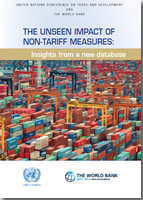
Edwin Newman, the newscaster and defender of the English language, objected to the term “non-dairy creamer” because it tells you what it isn’t but not what it is. He may have had the same view of “non-tariff measures”, an elusive class of measures that inhabit the twilight zone between trade policy and national regulation. From import licensing to technical regulations, from procurement preferences to subsidies, a large number of policies and regulations are classified as non-tariff measures (NTMs). They are pervasive across countries and over time. And their variety makes them much harder to measure than tariffs.
Businesses have long identified non-tariff measures as affecting their ability to trade. But the opacity and complexity of these measures have been impediments to the discourse on this critical issue. That is why this report and the underlying data and research are a tremendously valuable contribution. The NTM data now covers 90 percent of trade and all large importers that serve as main destination markets for developing countries.
This information allows us to assess the development implications of NTMs. The evidence confirms the views held by the majority of businesses that NTMs today have a bigger influence on trade than tariffs. Developing country exports are impeded by these measures but developing countries are also using these measures, often in a way that hurts exports of other developing countries. This evidence should help efforts to streamline NTMs at the national level and facilitate international cooperation to reduce their adverse impact.
This exercise is also a powerful example of collaboration between UNCTAD, the World Bank and a number of other international organizations. UNCTAD has for many years led work in this area. The involvement of the World Bank and other organizations over the last few years has provided an additional boost and made it possible to reap synergies in data design, collection, dissemination and research. This work demonstrates how much we can accomplish when we combine our efforts.
Looking ahead, we must continue work on two fronts. The first challenge is to keep NTM data collection alive. Far too often, our data collection efforts have been sporadic rather than sustainable, driven by the generosity and interests of donors rather than a durable institutional commitment. We need to work harder to mobilize resources to widen the coverage of the data and ensure that it is updated at regular intervals.
This effort must include strengthening capacities in countries to jointly collect and maintain the data. The second challenge is to build on the valuable current research and improve our ability to quantify and assess the impact of individual NTMs. We need to be better equipped to sift the legitimate from the protectionist measures. This would also help us to improve the design of trade rules so that they allow adequate space for desirable action while disciplining the dubious. It would also be helpful for national policy reform, in these challenging times, to better understand the political economy forces that dictate the choice of specific measures.
We must not lose the momentum that has been generated and recommit to reducing hurdles for businesses in developing countries.

Director, Division on International Trade and Commodities
UNCTAD

Senior Director, Development Economics
The World Bank



